
10 Successful Novel Localization All the Time
Successful novel localization requires beyond translating words as it involves adapting cultural nuances, preserving the essence of the story, and ensuring the output whether it resonates with a different audience through language, context, and sensitivity to themes. For those of you who want to read one of these forms of entertainment, here are 10 recommendations that can accompany you in spending leisure time.
The Little Prince by Antoine de Saint Exupéry

The Little Prince is a successful novel localization, boasting phenomenal sales of over 140 million copies worldwide. With translations into 300 languages and dialects, it has reached the hands of 2 million international readers. In fact, it is second only to the Bible that is the most translated and widely read. Its popularity has diverse adaptations across various mediums, including screen, opera, stage, radio, and more. Moreover, this one captivates readers with its fascinating attributes, as follows:
Depth in Simplicity. Although often perceived as a children’s story, its themes delve into profound aspects of human nature, relationships, and life’s intricacies, resonating deeply with many adults.
Author’s Life Reflected. Saint-Exupéry, an aviator, intricately weaves his own aviation experiences and encounters with diverse cultures into the narrative.
Personal Illustrations. Beyond its narrative, the book's allure is heightened by Saint-Exupéry's original watercolor illustrations, an integral element of its charm.
Enigmatic Disappearance. Saint-Exupéry’s mysterious vanishing in 1944 during a reconnaissance flight over the Mediterranean, while serving in World War II, left his fate unknown until decades later when wreckage from his plane was discovered.
Memorable Quotes. Endowed with unforgettable quotes like “What is essential is invisible to the eye” and “One sees clearly only with the heart; the essential is invisible to the eyes,” it leaves an indelible mark on readers worldwide.
IQ84 by Haruki Murakami
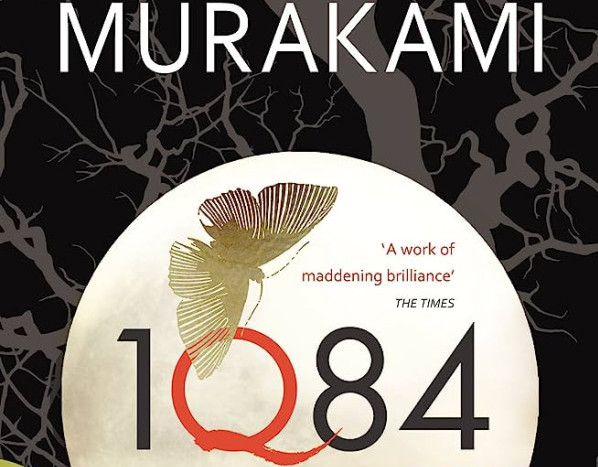
Released in three volumes in Japan, 1Q84 sold out upon its debut to the local audience right away. Within the initial month of its release, over 1 million copies were purchased. Following its translation into 42 languages, the book garnered widespread international interest, securing top positions on bestseller lists across the globe.
In fact, as a successful novel localization, IQ84 provides such a reading experience with these points:
Unique Narrative. The book offers a unique narrative, merging some genres, such as fantasy, romance, and dystopian elements to weave a complex tale of alternate realities and the interconnected lives of its main characters.
Cultural Impact. For Murakami, 1Q84 added to his achievements, establishing him further as a revered contemporary author with international influence.
The Alchemist by Paulo Coelho

The Alchemist is written in Portuguese and has undergone translation into 70 languages. This extensive translation effort has resulted in the sale of over 65 million copies since its debut in 1988. Furthermore, there are discussions about adapting the book into a film.
If you are interested to read this one, let’s deep dive into the facts to boost your excitement
The Enticing Theme. Appreciated for its philosophical insights and motivational themes centering on personal legend, destiny, and the pursuit of dreams, The Alchemist resonates deeply with readers, leaving a lasting impact regardless of cultural or linguistic differences.
Global Influence. The book’s extensive translations, remarkable sales, potential cinematic adaptation, and profound messages have firmly established The Alchemist as a literary phenomenon with a significant and enduring cultural resonance.
The Vegetarian by Han Kang
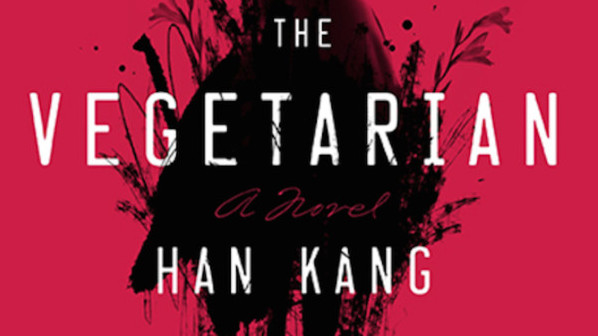
The Vegetarian stands out as a magnificent body horror that delves into the notion of the human body as both stunning and dreadful. This debut, divided into three parts, orbits around Yeonge-hye, a woman considered unremarkable by her husband. Despite being the catalyst for the narrative’s progression, her story isn’t narrated in her own voice, instead shifting perspectives across sections.
Moreover, in the section titled “Mongolian Mark,” her brother-in-law fixates on a birthmark on her backside, turning her into an object for his artistic endeavor, effectively erasing her individuality. This scene, both terrifying and aesthetically compelling, echoes the novel’s overall tone.
As a successful novel localization, what other enticing facts about Han Kang’s work? Continue reading for the elaboration below!
Challenging Social Conventions. Han Kang delves into societal taboos, exploring themes of mental health, individual autonomy, and the conflicts arising from straying from societal norms. The writer then plumbs the psychological depths of characters, notably Yeong-hye, unraveling the intricacies of the human psyche, trauma, and the consequences of personal choices on mental well-being.
Symbolic Representation. Vegetarianism in the book symbolizes rebellion, personal empowerment, and the pursuit of autonomy within a society that often enforces conformity.
Cultural Reflection. Providing a glimpse into South Korean culture, the book illuminates the pressures and hurdles individuals encounter when diverging from conventional societal expectations.
Open-Endedness. The novel’s indeterminate conclusion invites readers to delve deeply into its themes, fostering varied interpretations and discussions.
Animal Farm by George Orwell
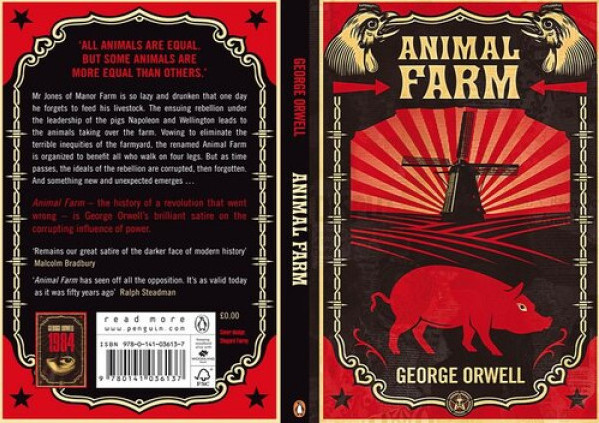
Animal Farm by George Orwell is an allegorical fiction that comments on the Russian Revolution of 1917 and the ensuing Stalinist period in the Soviet Union. The story unfolds on a farm where animals, led by the pigs, overthrow their human owner, Mr. Jones, striving to establish a utopian society where equality reigns.
Initially, the animals create a system rooted in fairness and equality, expressed through the Seven Commandments, notably “All animals are equal.” Pigs, especially Napoleon and Snowball, rise as leaders, with Snowball advocating progress through education and technology, while Napoleon focuses on power consolidation.
This short novel critiques totalitarianism, the distortion of revolutionary ideals, and power dynamics, drawing parallels to historical events and human behavior. Orwell’s use of animal characters and a straightforward narrative delivers a poignant message about power’s corrupting influence and the potential for revolutions to be manipulated by those seeking dominance.
Enduring Significance. Despite depicting a specific historical era, Animal Farm remains relevant in diverse political contexts and eras. Its universal themes of power, corruption, manipulation, and the risks inherent in revolutions continue to resonate.
Educational Importance. Widely incorporated into educational programs globally, the short novel isn’t just valued for its literary qualities, but also for its capacity to prompt critical thinking and discussions about politics and societal frameworks.
Debates and Perspectives. Since its release, Animal Farm has spurred discussions and diverse interpretations. Readers engage in ongoing analysis of its themes, characters, and messages, fostering a range of discussions exploring its deeper implications.
Read also: 10 Best-selling Translated Novels 2023: Which One is Your Favorite?
Pride and Prejudice by Jane Austen
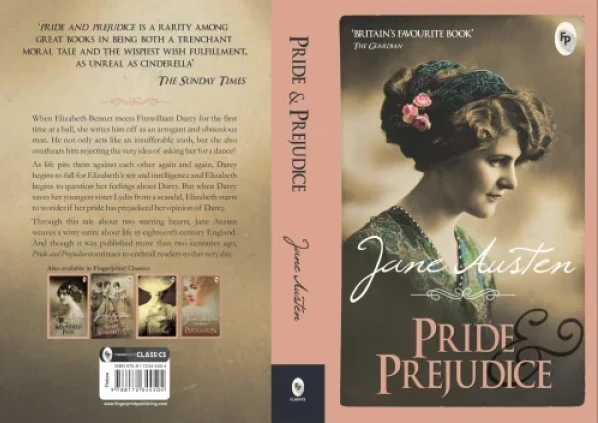
Pride and Prejudice by Jane Austen is a classic novel set in early 19th-century England. It centers on the romantic affairs of the Bennet family, particularly focusing on the sharp and clever Elizabeth Bennet and the wealthy, Mr. Fitzwilliam Darcy.
The Bennet family, comprising Mr. and Mrs. Bennet and their five daughters grapple with societal and financial pressures due to the absence of male heirs, prompting the need to secure their daughters’ futures through marriage. The arrival of wealthy bachelor Mr. Charles Bingley and his companion, Mr. Darcy, triggers a sequence of events shaping the storyline.
Having been published since 1813, how does this successful novel localization still have fans today? This is linked with the following facts:
Innovative Female Lead. Elizabeth Bennet, the central character, stands as a notable and independent figure in literature. Her intellect, wit, and defiance against societal norms establish her as a groundbreaking personality within the novel’s historical context.
Use of Satire. Austen employs satire in the book to playfully critique prevalent social behaviors, contradictions, and biases prevalent in the society of her era. Her skillful use of wit and irony enriches both the narrative and the characters.
Cultural Impact. Pride and Prejudice has spurred multiple adaptations across diverse media platforms, including cinema, television, theater, and contemporary reinterpretations. Its enduring themes and characters remain a source of reimagining for modern audiences.
Significance of the Title. Pride and Prejudice aptly encapsulates the novel’s core themes, highlighting the hurdles characters face due to their preconceived notions and personal pride. It emphasizes the necessity of overcoming individual biases for growth and understanding.
Reception and Endurance. Initially published anonymously, the novel gradually gained acclaim and popularity, eventually securing a place as one of Jane Austen’s most cherished and enduring works.
To Kill a Mockingbird by Harper Lee
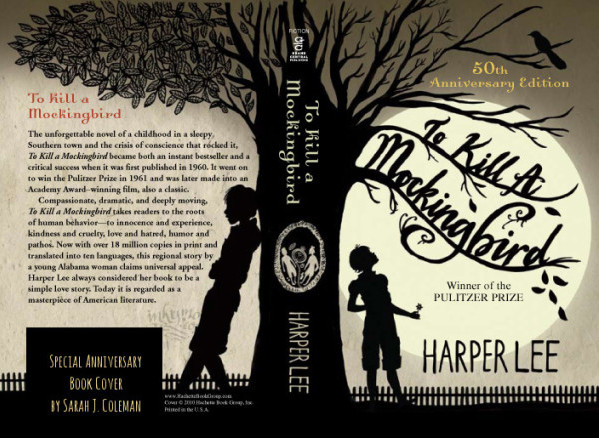
Harper Lee, widely regarded as one of the most influential authors, notably released only a single novel until a contentious sequel emerged in 2015 shortly before her passing. Her classic work, To Kill a Mockingbird, debuted in 1960.
The narrative navigates the landscape of racism in the American South through the innocent perspective of a bright young girl named Jean Louise (Scout) Finch. Its memorable characters, especially the compassionate and principled lawyer and father, Atticus Finch, became emblematic figures, reshaping perspectives during a period of heightened racial tensions in the United States.
Furthermore, what’s the other things to be noted for this successful novel localization? Let’s check it out!
Pulitzer Prize. Harper Lee received the Pulitzer Prize for Fiction in 1961, acknowledging the significant literary contribution of To Kill a Mockingbird merely a year after its release.
Social Influence. During the Civil Rights Movement, this novel became instrumental in shaping discussions on racial injustice in the United States, serving as a powerful tool to address societal issues and foster empathy.
Adaptation into Film. The novel successfully transitioned into a film in 1962, securing three Academy Awards, further reinforcing its impact and reaching a wider audience.
Autobiographical Elements. The writer’s upbringing in Monroeville, Alabama, inspired the fictional setting of Maycomb in the novel, reflecting her own Southern experiences and potentially influencing the narrative's backdrop.
Delayed Sequel. Following the successful work, Harper Lee abstained from releasing another book for several decades. However, the controversial publication of Go Set a Watchman in 2015 marked a significant return to the literary scene.
The Kite Runner by Khaled Hosseini
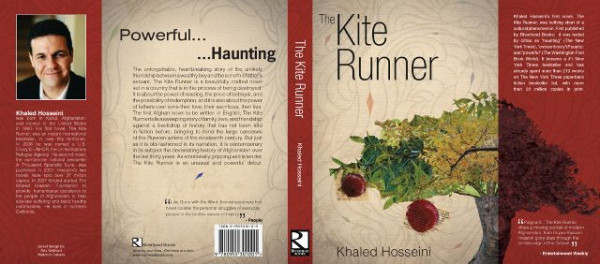
Prepare for emotions when delving into The Kite Runner. Released in 2003 as a debut work, this poignant narrative unfolds against Afghanistan’s tumultuous backdrop, focusing on the profound friendship between a privileged young boy and the son of his father’s servant. At its core, this modern classic beautifully explores the potency of friendship and the enduring ties between fathers and sons.
Get to know more about the fascinating things of the Kite Runner by scrolling down!
Inspiration from Personal Experiences. Hosseini, like his protagonist Amir, was born in Kabul, Afghanistan, and later moved to the United States. His personal background heavily influenced the novel's setting and themes, providing an authentic portrayal of Afghan culture and history.
Exploration of Guilt and Redemption. The novel delves into themes of guilt, betrayal, and redemption, as the main character, Amir, grapples with the consequences of his actions and seeks atonement for past mistakes. Cultural and Historical Context. Hosseini skillfully weaves Afghan history and culture throughout the narrative, providing readers with insights into the country’s transformation from its pre-Soviet invasion era to the Taliban regime and subsequent diaspora.
Adaptation into Film. In 2007, The Kite Runner was adapted into a movie, introducing the story to a wider audience. The film captured some of the novel's essence, though it faced controversy regarding its depiction of sensitive scenes.
Impact on Discussions about Immigration and Identity. The novel contributed to discussions about immigration, cultural identity, and the refugee experience, shedding light on the struggles faced by individuals navigating between two cultures.
Literary Awards. Hosseini’s novel received numerous literary awards and nominations, including the South African Boeke Prize and the California Book Award for Fiction.
Read also: 5 Novel Applications with Their Advantages and Disadvantages
The Graveyard Book by Neil Gaiman

The Graveyard Book by Neil Gaiman tracks the life of Nobody Owens, or Bod, raised by spectral residents of a graveyard following his family’s tragic murder. Under the care of his guardian Silas and tutelage from the graveyard’s inhabitants, Bod acquires unique skills, learning the art of fading and communing with the deceased.
Maturing amidst the realms of the living and the dead, Bod embarks on adventures and confronts perils in both worlds. He forges friendships, unravels his origins, and uncovers hidden truths linking him to his family's fate.
Fusing fantasy, mystery, and themes of coming-of-age, the narrative intricately melds the supernatural with the trials and revelations of growing up. Ultimately, Bod faces his history, embracing his fate while harmonizing the realms of the living and the dead.
Interested in reading this unique story? Here are facts that can help you determine whether this is your next reading choice.
Inspiration from The Jungle Book. Neil Gaiman found creative inspiration in Rudyard Kipling’s The Jungle Book while penning this novel. Departing from the jungle setting, he conceived a tale unfolding within a graveyard, where a young boy is nurtured by supernatural entities.
Multiple Accolades. The book garnered esteemed recognition, clinching the Hugo Award for Best Novel in 2009, the 2009 Newbery Medal for its significant contribution to American children's literature, and the 2009 Locus Award for Best Young Adult Book.
Serialized Publication. Initially, this successful novel localization was serialized, with individual chapters released sequentially before the full novel was published.
Illustrative Editions. Various editions of the novel featured illustrations by celebrated artists like Dave McKean, Chris Riddell, and others, enriching the visual aspect of the narrative.
Audiobook Narrated by Neil Gaiman. Neil Gaiman personally narrated the audiobook rendition of his work, infusing his distinctive voice and storytelling prowess into the audio presentation.
Adaptation Efforts. There have been endeavors to adapt the book into either a film or television series; however, no completed production has emerged thus far.
Totto-Chan by Tetsuko Kuroyanagi
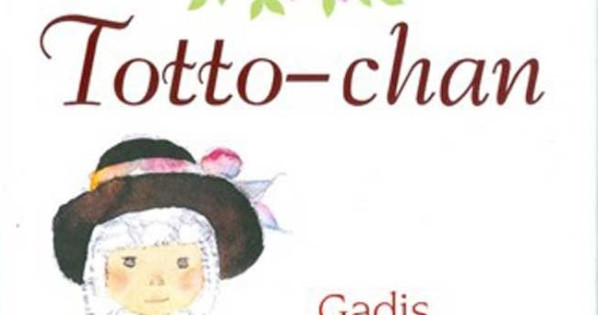
Totto-chan: The Little Girl at the Window is an autobiographical novel by Tetsuko Kuroyanagi. It chronicles her formative years attending the distinctive Tomoe Gakuen, an elementary school in Tokyo.
Tetsuko, affectionately known as Totto-chan, possesses an inquisitive nature and an enthusiastic love for learning. Struggling in conventional schooling, she finds solace at Tomoe Gakuen, an unconventional institution established by Mr. Kobayashi. The school’s core focus revolves around nurturing creativity and fostering individuality among its students.
At Tomoe Gakuen, Totto-chan encounters a nurturing atmosphere that encourages exploration of interests, experiential learning, and uninhibited self-expression. The school’s innovative design features classrooms fashioned like train cars, and teachers adapt their teaching styles to cater to each child's unique learning preferences.
Throughout the narrative, Totto-chan shares heartwarming anecdotes of her escapades at the school, the valuable insights imparted by Mr. Kobayashi and other educators, and the enduring bonds she forms with her classmates. The book celebrates the importance of unorthodox educational methods and their profound impact on childhood development.
Sounds cute? Know the facts about this lovely book to strengthen you in reading it after this.
Personal Memoir. Totto-chan serves as the writer’s autobiographical recollection of her schooling days at Tomoe Gakuen, an unconventional institution in Tokyo.
Japanese Acclaim. Totto-chan achieved remarkable success in Japan, emerging as a bestseller esteemed for its touching narrative and insights into non-traditional learning.
Global Reach. The book underwent translations into multiple languages, earning international applause by captivating readers worldwide with a young girl’s singular educational journey.
Adaptations. The book underwent adaptations, including television dramas and movies in Japan, widening its impact and outreach across diverse media platforms.
Read also: 6 Challenges in Novel Localization
The successful novel localization hinges on the writer’s skill in expressing the narrative through selected themes and language, though the translator’s contribution is equally significant. Among the suggested options, which book captures your immediate interest for reading? Even if your selection doesn’t perfectly match your broader thematic preferences, a well-executed adaptation promises an enjoyable reading encounter by authentically reflecting your cultural context.